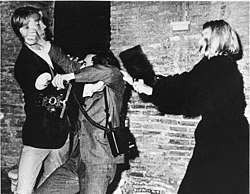Due to the reputation of paparazzi as a nuisance, several countries and states restrict their activities by passing laws and by holding events in which paparazzi are specifically not allowed to take photographs. [34] [35] [36] [37] In the United States, celebrity news organizations are protected by the First Amendment, [38] which means that taking photos or videos of people in public areas without their consent is legal. [39] This standard extends to even potentially embarrassing situations. For example, in July 2012, when Australian supermodel Miranda Kerr leaned over to buckle her son into a car seat, her thong underwear peeked over her jeans to create a whale tail. Because she was in a public location, the streets of New York City, the photographer not only had the right to take photos but also circulate them publicly. [40] However, to protect the children of celebrities, California passed Senate Bill No. 606 [41] in September 2013. The purpose of the bill is to stop paparazzi from taking pictures of children or wards in a harassing manner because of their parent's occupation. This law increased the penalty for harassment of children. [42] California Civil Code sections 1708.7 and 1708.8 explicitly address stalking and invasion of physical privacy. [43] [44]
Injunctions
In 1972, paparazzo photographer Ron Galella sued Jacqueline Kennedy Onassis after the former First Lady ordered her Secret Service agents to destroy Galella's camera and film following an encounter in New York City's Central Park. Kennedy counter-sued claiming harassment. The trial lasted three weeks and became a groundbreaking case regarding photojournalism and the role of paparazzi. In Galella v. Onassis, Kennedy obtained a restraining order to keep Galella 150 feet (46 m) away from her and her children. The restriction was later reduced to 25 feet (7.6 m). The trial is a focal point in Smash His Camera , a 2010 documentary film by director Leon Gast.
In 1997, Diana, Princess of Wales and partner Dodi Fayed were killed in a limousine crash as their driver was speeding, trying to escape paparazzi. Another person, Trevor Jones, survived. [45] [46] An inquest jury investigated the role of paparazzi in the incident, but no one was convicted. The official inquests into the accident attributed the causes to the speed and manner of driving of the Mercedes, as well as the following vehicles, and the impairment of the judgment of the Mercedes driver, Henri Paul, through alcohol. [47]
In 1999, the Oriental Daily News of Hong Kong was found guilty of "scandalizing the court", an extremely rare charge where the judiciary find that the newspaper's conduct undermines confidence in the administration of justice. [48] The charge was brought after the newspaper had published abusive articles challenging the judiciary's integrity and accusing it of bias in a lawsuit the paper had instigated over a photo of a pregnant Faye Wong. The paper had also arranged for a "dog team" (slang for paparazzi in the Chinese language) to track a judge for 72 hours, to provide the judge with first-hand experience of what paparazzi do. [49]
Time magazine's Style & Design special issue in 2005 ran a story titled "Shooting Star", in which Mel Bouzad, one of the top paparazzi in Los Angeles at the time, claimed to have made US$150,000 for a picture of Ben Affleck and Jennifer Lopez in Georgia after their breakup. "If I get a picture of Britney and her baby," Bouzad claimed, "I'll be able to buy a house in those hills [above Sunset Boulevard]." [50] Paparazzi author Peter Howe told Time that "celebrities need a higher level of exposure than the rest of us so it is a two-way street. The celebrities manipulate."
In 2006, Former Brazilian Model Daniella Cicarelli went through a scandal when a paparazzo caught video footage of her having sex with her boyfriend on a beach in Spain, which was posted on YouTube. [51] After fighting in the court, it was decided in her favor, causing YouTube to be blocked in Brazil. Cicarelli appealed the decision, and the case was finally settled in 2015 with the Superior Court of Justice of Brazil awarding Cicarelli and her boyfriend in the video damages of R$250,000 (US$64,000) from Google. [52]
Following the publication of photographs showing Catherine, Princess of Wales sunbathing whilst topless at the French holiday home of her husband's cousin Viscount Linley, it was announced on September 14, 2012, that the royal couple were to launch legal action against the French edition of Closer magazine. It was the first time that a senior British royal has sued in a court outside the UK. The reason cited for the legal action is that the Duchess had a right of privacy whilst at the home—the magazine responded that the pictures had been taken from the public highway. The injunction was granted on September 18, 2012, and the publishers of the magazine were ordered not to publish the photographs in France and not to sell the images. The publishers were also ordered to hand over the original material of the published pictures under threat of a €10,000 fine for every day of delay in doing so. [53] In 2017, the magazine was ordered to pay €100,000 in damages to Catherine and William, and another €90,000 fine to two staffers. [54]
In the United Kingdom, Sienna Miller, Amy Winehouse, and Lily Allen have won injunctions that prevent the paparazzi from following them and gathering outside their houses. Miller was awarded £53,000. [55]
In 2013, rapper Kanye West faced assault charges after attacking a photojournalist. He stated that he would fight to get the law changed, so celebrities can profit from paparazzi's work. [56] [57]


